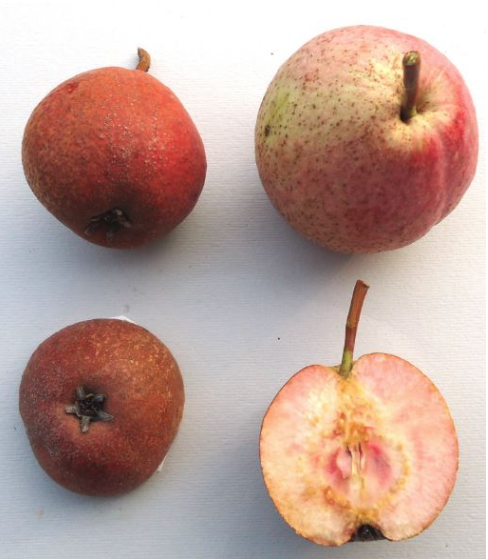Crop: Pyrus communis L. (Pear)
The name ‘Pera cocomerina’ (literally ‘watermelon pear’) is related to a peculiar feature of mature fruits produced by this landrace: at maturity the fruit is characterised by a typical reddish flesh due to abundant presence of anthocyanins. This landrace can be generally found in Central Italy at relatively high altitudes on the Apennine mountains. The tree is characterised by high vigour and upright tree habit. Plants are characterised by good productivity even during harsh seasons. Annual branches young leaves are both characterised by a slightly reddish colour. Flowers are cream-white while stamen are dark red. Plant typically produce a great number of flowers that makes this landrace also a valuable ornamental plant. Fruits are small-medium size (from 65 to 110 gr) and characterised by round shape and a quite thin skin. Flesh is red, juicy and appreciated for its typical taste and aroma. Currently two types of ‘Pera cocomerina’, characterised by different maturation periods, are cultivated: The early-type (‘Cocomerina precoce’) is picked in mid-August and is characterised by a slightly red flesh while the late-one (‘Cocomerina d’inverno’) is ready in mid-October , carrying darker red flesh pears.
Cultivation System: low input conditions.
Geographical Information
Country: Italy
‘Pera cocomerina’ was traditionally cultivated in the Province of Cesena (Emilia-Romagna, Italy), on the Apennine mountains. Nowadays, its cultivation is still carried out in the same area. Currently, its production occurs in Ville di Montecoronaro, a small village within the municipality of Verghereto (Cesena, Italy), located at the foot of Mount Fumaiolo.
Farmer(s) description:
Typically, plants are conserved within private orchards and farms. Currently, about 40 plants are conserved, still productive and used to produce jam and a typical liquor. In 2019, the Association ‘Pro Loco Ville’ planted a small orchard of ‘Pera Cocomerina’.
Propagation system: Clonal
Multiplication procedures and consequences on landrace diversity:As other pear varieties, this landrace is propagated by grafting onto rootstocks. The propagation activity was mainly carried out by the Foundation named ‘Archeologia Arborea’ (San Lorenzo – Lerchi, Perugia, Italy). Currently, the vegetative propagation of this landrace is carried out to produce few individuals using wild rootstocks.
The use of grafting starting from very few individuals causes reduction of the within population genetic diversity. Anyhow, the vigour of the grafted plants together with their adaptability to different soils can be managed through selection of proper rootstocks.
Management plan existence:The landrace management relies completely on farming activities in the area. Currently, no technical or scientific support is given.
Added Values
Currently, no local or national market exists as the production of ‘Pera cocomerina’ is carried out by few farmers/gardners, conserving from 1 to 6 individuals each. Currently, the production is used to produce jam and a typical pear liquor that are sold during the annual event ‘Sagra della Pera Cocomerina’.
Others (e.g. commercial/geographical brands or special traits):In 2011, ‘Pera cocomerina’ (det. n° 16102 del 12/12/2011) was included into the regional register of landraces (Emilia Romagna Region, Italy) implementing the regional Law concerning the protection of local genetic resources (n. 1, January the 29th, 2008).
The cultural association ‘Pro Loco Ville’ (http://www.peracocomerina.it/beta/2587-2/) is a local association of the district of Ville di Montecoronaro (Verghereto, Cesena, Italy) whose main aims is conservation and use of ‘Pera Cocomerina’. The association has been involved for decades in the valorisation, preservation and promotion of this landrace. Throughout the past decvades, Pro Loco Ville favoured conservation of the landrace and created an annual event named ‘Sagra della Pera Cocomerina’ (http://www.peracocomerina.it/beta/le-sagre/) to promote the product and its derivates.
The landrace also caught the interest of the Slow Food movement which included it among its ‘presidia’.
Currently, ‘Pera cocomerina’ is conserved in the tree collection (ex-situ) belonging to ‘Foundation named ‘Archeologia Arborea’ (San Lorenzo – Lerchi, Perugia, Italy).
Provisions set by the local organisations aimed at characterising and saving the landrace: in 2019 a small orchad was planted to preserve the landrace and at the same time to slightly increase the production. However, at present, further activities are needed to enhance on-farm conservation and to increase the use of such resource
Uncertain. To have access to the resource ‘Regione Emilia-Romagna’ (http://agricoltura.regione.emilia-romagna.it/agrobiodiversita/doc/agrobiodiversita-vegetale/pero) should be contacted.
Most of updates have been retrieved from Regione Emilia-Romagna website (http://agricoltura.regione.emilia-romagna.it/agrobiodiversita/doc/agrobiodiversita-vegetale/pero/cocomerina-dinverno & http://agricoltura.regione.emilia-romagna.it/agrobiodiversita/doc/agrobiodiversita-vegetale/pero/cocomerina-precoce ). Information were also communicated by members of ‘Pro-loco Ville’ (Ville di Montecoronaro, Cesena, Italy).
ND.
